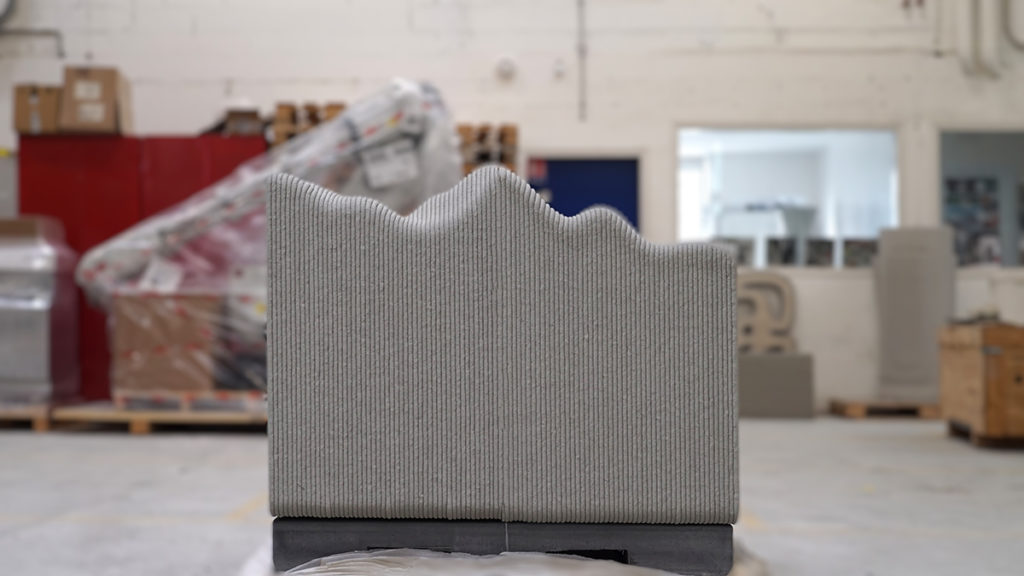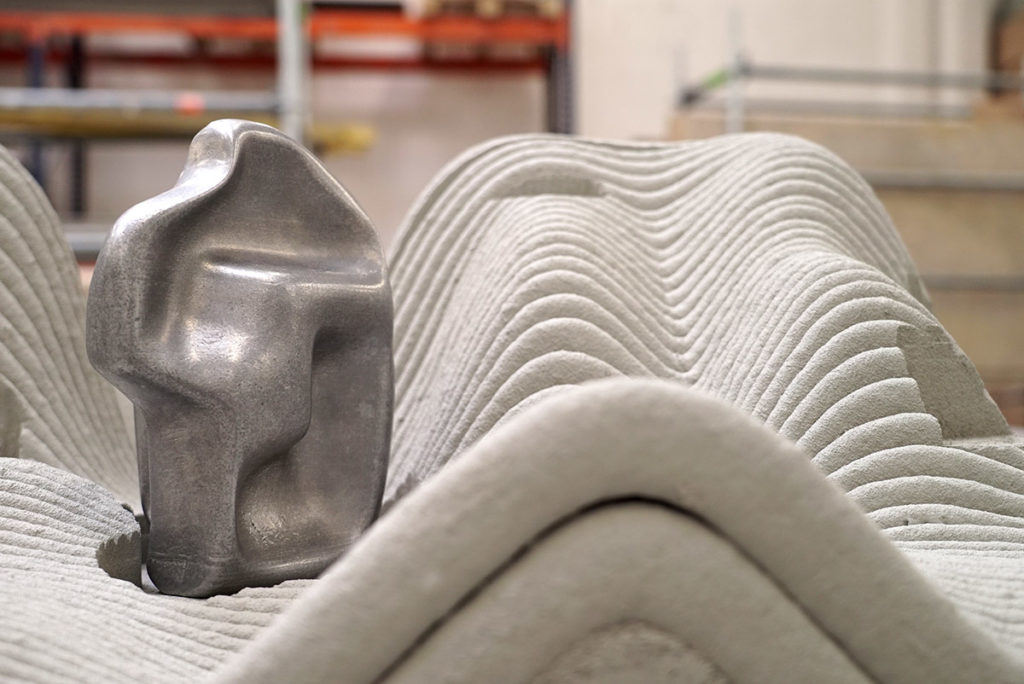Internes – Prix MAIF







“La forme est vacuité et la vacuité elle-même est forme ; la vacuité ne diffère pas de la forme, la forme ne diffère pas de la vacuité ; tout ce qui est forme est vacuité, tout ce qui est vacuité est forme ; il en est de même des sensations, des perceptions, des volitions et de la conscience (…) Ils n’augmentent ni ne diminuent.” (Sûtra du Cœur)
Internes est un ensemble de sculptures qui pourrait recouvrir la Terre en totalité et constituer une seconde peau planétaire. Il appartient à un monde à venir où l’humanité, à la suite de catastrophes répétées, aurait décidée de briser le cercle infernal de l’extractivisme, du productivisme et du consumérisme hérité de la révolution industrielle.
Toutes les productions matérielles serviraient de support à la réalité augmentée, formant une réalité grise et stable dont le changement serait visible uniquement grâce à des interfaces technologiques. La réalité serait alors creusée par une absence, un manque, une lacune, un monde troué par le désir humain.
En collaboration avec Goliath Dyèvre, dans la série “L’augmentation des choses”.
Avec le soutien du prix sculpture de la MAIF, DICREAM, Seconde Nature.
Texte d’Ingrid Luquet-Gad
Nous voici dans un monde où tout est gris. Tout, car une gelée grise recouvre progressivement la surface du globe terrestre. Bientôt, le processus sera achevé : l’issue est asymptotique mais l’expansion, elle, inéluctable. Et pourtant, ce monde, tel que nous en faisons l’expérience, se pare en même temps de couleurs chamarrées. Ses reflets sont moirés et ses contours ondoyants. Plutôt qu’un paradoxe logique ou qu’une dissociation paranoïaque, les deux dimensions sont à considérer ensemble. Désormais, elles coexistent, et même, se génèrent et s’augmentent l’une l’autre. Le projet Internes de Grégory Chatonsky et Goliath Dyèvre permet d’en faire l’expérience. Ainsi, pour chacun des modules d’un mètre carré qui le composent, potentiellement démultipliables à l’infini pour recouvrir une surface coextensible à la planète, un support physique accueille une matière numérique. L’immuabilité du socle en béton, réalisé à partir d’une imprimante 3D, est chapeauté d’une augmentation empreinte la versatilité d’une visualisation en temps réel, générée à partir des données de l’était sismique et géologique de la terre.
A l’échelle de la planète, l’expérience de pensée convoque un futur spéculatif dont on ne saurait pour l’instant, à défaut d’en préciser davantage les contours et les paramètres, décider s’il relèverait de l’utopie et de la dystopie. A celle, réduite et fragmentaire, d’une parcelle de ce monde qui nous serait d’ores et déjà donné, et dont il nous est dès lors, face aux modules, donné d’éprouver la texture, les implications changent insensiblement. Alors, il ne s’agit plus tant d’un imaginaire possible que d’une perception altérée, moins d’une extrapolation fantasmée que d’une alerte pressante. Le projet ne saurait se concevoir sans sa part spéculative : son impulsion naît d’une impasse d’époque, celle du productivisme à outrance, de la panne de l’innovation et de l’impasse des discours décroissants. Des éléments en aluminium, en outre, constellent chacun des modules en béton, introduisant à la rémanence fossilisée d’une ère industrielle qui, déjà, touche à sa fin.
Internes déploie ainsi expérience paradoxale : celle de concilier une temporalité triple, résolue par l’appréhension dans l’espace d’exposition. La perception est à la fois corporelle, mobilisant la vision nue pour le socle en béton, présent, et ses fossiles, passés, tout autant qu’elle est appareillée, en nécessitant, pour l’augmentation numérique générée depuis l’hyperprésent de la visualisation, de compléter ce premier accès au réel de l’œuvre par le second qui se donne sur l’écran du smartphone du visiteur. Alors se donnent ensemble les trois dimension temporelles, résolvant, par l’implication corporelle que nécessitent les arts de l’espace, et par la négociation technique d’une vision prosthétique, l’apparent paradoxe. La forme naît, dans la combinatoire de ses dimensions auparavant, et logiquement, conçues comme inconciliables, et la synthèse opère. L’objet se révèle et, dès lors, l’expérience de pensée, à son tour, ne paraît pas si extravagante. Un monde, à son tour, naît et une réalité éclôt, en équilibre sur le fil tranchant de cet impossible logique : un monde plus grand à l’intérieur qu’à l’extérieur.
Réponse par l’absurde à l’hyperproduction effrénée, Internes amène la possibilité d’un changement de perspective par la résolution incarnée d’un paradoxe. Ce faisant, il enclenche, et ce, dès l’appréhension d’un seul bloc augmenté d’un mètre carré, l’imagination d’un changement effectif qui, lui, concernerait, à cette autre échelle, plus vaste voire planétaire, la possibilité d’envisager d’autres manières, spéculatives et pourtant éminemment matérielles et concrètes, d’habiter autrement la planète – alors même qu’en cette année qui s’achève, le poids des produits manufacturés dépasser désormais celui la biomasse du monde naturel.
“Form is emptiness and emptiness itself is form; emptiness does not differ from form, form does not differ from emptiness; all that is form is emptiness, all that is emptiness is form; the same is true of sensations, perceptions, volitions, and consciousness (…) They neither increase nor decrease.” (Heart Sutra)
Internes is a set of sculptures that could cover the entire Earth and constitute a second planetary skin. It belongs to a future world where humanity, following repeated catastrophes, would have decided to break the infernal circle of extractivism, productivism and consumerism inherited from the industrial revolution.
All material productions would be used as a support for augmented reality, forming a grey and stable reality whose change would be visible only through technological interfaces. Reality would then be hollowed out by an absence, a lack, a gap, a world pierced by human desire.
In collaboration with Goliath Dyèvre, in the series “L’augmentation des choses”.
With the support of the MAIF sculpture prize, DICREAM, Seconde Nature.
Text by Ingrid Luquet-Gad
Here we are in a world where everything is grey. Everything, because a grey jelly is progressively covering the surface of the earth. Soon, the process will be completed: the outcome is asymptotic but the expansion is inevitable. And yet, this world, such as we experience it, is at the same time adorned with bright colors. Its reflections are moiré and its contours undulating. Rather than a logical paradox or a paranoid dissociation, the two dimensions are to be considered together. From now on, they coexist, and even generate and increase each other. The Internes project by Grégory Chatonsky and Goliath Dyèvre allows us to experience this. Thus, for each of the one square meter modules that compose it, potentially infinitely multipliable to cover a surface coextensible to the planet, a physical support hosts a digital material. The immutability of the concrete base, made from a 3D printer, is topped by an increase in the versatility of a real-time visualization, generated from the data of the seismic and geological state of the earth.
On the scale of the planet, the experiment of thought summons a speculative future of which we would know for the moment, for lack of specifying more the contours and the parameters, to decide if it would belong to the utopia and the dystopia. To that, reduced and fragmentary, of a parcel of this world which would be already given to us, and of which it is from then on, in front of the modules, given to us to feel the texture, the implications change insensibly. Then, it is not so much a question of a possible imaginary as of an altered perception, less of a fantasized extrapolation than of an urgent alert. The project could not be conceived without its speculative part: its impulse is born of an impasse of time, that of the excessive productivism, of the failure of the innovation and the dead end of the decreasing discourses. Elements in aluminium, moreover, constellate each of the concrete modules, introducing the fossilized remanence of an industrial era that is already coming to an end.
Internes deploys thus paradoxical experience: that to conciliate a triple temporality, resolved by the apprehension in the space of exhibition. The perception is at the same time corporeal, mobilizing the naked vision for the concrete base, present, and its fossils, past, as much as it is equipped, by requiring, for the digital increase generated since the hyperpresent of the visualization, to supplement this first access to the real of the work by the second which is given on the screen of the visitor’s smartphone. Then the three temporal dimensions are given together, solving, by the bodily implication that require the arts of the space, and by the technical negotiation of a prosthetic vision, the apparent paradox. The form is born, in the combinatory of its dimensions before, and logically, conceived as irreconcilable, and the synthesis operates. The object reveals itself and, consequently, the experience of thought, in its turn, does not seem so extravagant. A world, in its turn, is born and a reality bursts out, in balance on the sharp edge of this impossible logic: a world bigger inside than outside.
A response by the absurd to unbridled hyperproduction, Internes brings about the possibility of a change of perspective by the incarnated resolution of a paradox. In doing so, it triggers, and this, from the apprehension of a single block increased by a square meter, the imagination of an effective change that would concern, at this other scale, more vast and even planetary, the possibility of envisaging other ways, speculative and yet eminently material and concrete, to inhabit the planet differently – even though in this year that is ending, the weight of manufactured products now exceeds that of the biomass of the natural world.
